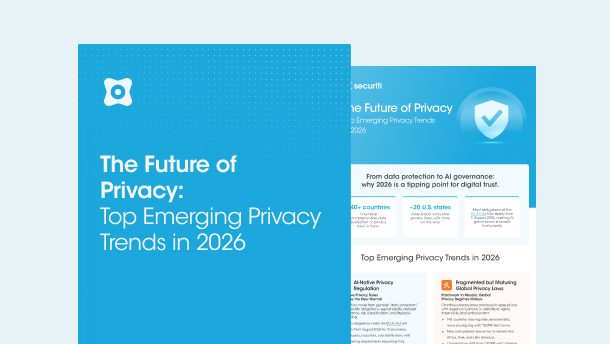In today's hypervolume data-driven era, organizations must have comprehensive visibility over their data assets. This visibility not only supports regulatory compliance but also enhances data security and operational efficiency. By accurately mapping data sources and flows, organizations can better manage risk and ensure that personal information is processed in accordance with data protection laws such as the GDPR, CPRA, LGPD, etc.
Data mapping is the foundational process that ensures data from diverse systems can be accurately and effectively cataloged, enabling assessments, residency, access rights, etc. As organizations strive to maximize the potential of their data assets while complying with evolving regulatory requirements, implementing the best data mapping practices becomes essential.
What is Data Mapping?
Data mapping is the process of cataloging an organization's data assets and detailing how each asset is created, stored, processed, shared, archived, and deleted. This foundational process supports essential operational needs across the organization:
- It enables organizations to organize, catalog, and structure their stored data.
- It improves an organization's efficiency in data management and protection by identifying and securing sensitive or high-risk data.
- It enables organizations to track where their data is flowing, which helps maintain adequate records of data processing activities, including how data is being processed or stored, where it is transferred to, and the risks associated with its processing.
- It enables organizations to easily access and identify relevant data whenever required, allowing better data leveraging for business operations.
- It also allows organizations to improve their security practices by establishing controlled access both internally and externally.
Why is Data Mapping Important?
Data mapping can be beneficial for any organization in several ways.
Compliance with Data Privacy Laws
Data mapping is essential for privacy compliance and data governance as it provides a comprehensive view of an organization’s data assets. In particular, it tracks an individual’s personal data collected and processed, enabling organizations to implement tight security and privacy controls in place to comply with privacy regulations such as the EU’s GDPR or CPRA. This visibility helps reduce compliance risks and facilitates audit readiness.
Identification of Vulnerabilities
Often, data is collected through manual spreadsheets or surveys, which can be complex and time-consuming, prone to inconsistencies, errors, and incompleteness. Their usage increases the risk of non-compliance and data breaches. With data mapping, organizations can more easily identify potential data breach points and weak spots, allowing for preemptive improvements in security measures and minimizing liability. Furthermore, as regulations and data landscapes evolve, automated and up-to-date data mapping becomes crucial for maintaining compliance.
Accurate Transfer of Data
Data mapping is significant as it supports reliable data transfer and transformation across systems, facilitating seamless data integration and usage, consistent data quality, and well-informed decision-making.
Learn more about what data mapping is?.
Best Practices to Follow in Data Mapping
1. Conduct Comprehensive Data Discovery
Organizations must conduct comprehensive data discovery, which involves utilizing automated discovery tools to scan and identify all data sources across the organization and documenting structured and unstructured data. This provides a complete and accurate view of the data landscape.
2. Identify & Engage Stakeholders
Organizations must identify and engage with key stakeholders, including data stewards, owners, and authorized users, to gain a better understanding of data at hand and build a robust data mapping process that best suits the organization’s operational and compliance needs.
3. Ensure Data Accuracy and Consistency
Organizations must ensure data accuracy and consistency by regularly updating data maps to reflect any changes in data structures or flows. This is essential for reducing compliance risks and maintaining high-quality data for analysis and decision-making.
4. Leverage Automation and AI
Organizations must leverage AI and machine learning tools to automate data discovery, cataloging, classification, and mapping processes. This saves time and resources and improves the overall process.
5. Document Data Flows
Organizations must create comprehensive visual maps to document how data travels across various systems and processes, including information on data sources, destinations, and access controls.
6. Ensure Regulatory Compliance
Organizations must stay informed about applicable data protection regulations and ensure that data mapping practices comply with these evolving requirements. It is generally recommended that data maps be reviewed and updated regularly to represent compliance with new or updated requirements.
7. Establish Data Quality
Organizations must establish data quality standards and metrics to assess and improve data quality. High data quality is essential for operational effectiveness, regulatory compliance, and customer trust.
8. Review and Optimize Regularly
Organizations should set up regular reviews to assess and optimize data mapping practices. This continuous improvement process ensures that data maps remain accurate, compliant, and aligned with evolving business and regulatory needs.
Common Challenges in Data Mapping
Despite its significance, data mapping presents several challenges:
Data Quality Issues
Inconsistencies may result from variations in data formats, units, or encoding between the source and destination systems. Additionally, duplicate entries in the original data may make the mapping procedure more complex, and incomplete data sets might limit accurate mapping and integration.
Complex Coordination
Obtaining information on data assets and processes is frequently a manual endeavor that necessitates complex coordination among privacy, IT, and other teams. In certain instances, organizations may also require external partners to collect this information.
The prevalence of outdated systems and data mapping approaches further complicates stakeholder engagement, leading to a significant risk of data sprawl and missing out on crucial information about certain systems or processes.
Additionally, conflict might result from various systems using different terminology to refer to the same concept. The mapping process might be complicated by the possibility that the same data piece will imply various meanings in different contexts.
Outdated Records
Due to the dynamic nature of data collection and flow, information on data asset processes may easily become outdated. This reduces the effectiveness of data management and increases compliance risks, as records may no longer reflect current data processing activities.
Scalability Concerns
Large dataset mapping and transformation tend to be resource-intensive and time-consuming. It is also demanding to ensure that the data mapping process operates efficiently without compromising system performance.
Certain data mapping tools may not have the sophisticated functionality required to manage complex changes, which can hinder the ability to respond to changing data structures and integration needs. Limitations in functionality can lead to inefficiencies and increased manual intervention.
Security and Privacy Concerns
Sensitive data requires rigorous handling to prevent unauthorized access and ensure compliance with data protection regulations. Mapping personal and sensitive data to its rightful owner is critical for security, as well as for meeting legal obligations. Failure to address these security concerns can expose organizations to significant compliance and reputational risks.
Optimize Your Data Mapping with Securiti
Securiti is the industry leader in data security, privacy, and governance automation.
Securiti’s Data Command Center leverages contextual data intelligence and automation to unify data controls across security, privacy, compliance, and governance through a single, fully integrated platform. Securiti data mapping automation helps organizations automate the process, which is crucial for compliance with data protection regulations such as GDPR, CCPA, etc.
Key Features of Securiti Data Mapping Automation
Comprehensive Data Discovery
Securiti automatically scans file systems, databases, cloud storage, and apps for both structured and unstructured data. It also collects and analyzes metadata to understand data types, structures, and relationships.
AI-Powered Data Classification
It utilizes machine learning to categorize and identify sensitive data, including financial information, health records, and personally identifiable information (PII). It further enhances classification accuracy by understanding the context in which data is used.
Data Relationship Mapping
It illustrates the data flows and relationships between the organization's systems and processes. It automatically creates maps showing the links between data elements in various databases, applications, and systems.
Records of Processing Activities (RoPA)
RoPA streamlines compliance with evolving data protection regulations by providing a comprehensive, up-to-date view of an organization's data processing activities. This enables organizations to reduce manual effort and improve overall data governance.
Regulatory Compliance
It generates compliance reports automatically as required by laws like the GDPR and the CPRA. Furthermore, it expedites the procedure for responding to queries about data subjects by promptly identifying and mapping relevant data.
Scalability and Flexibility
It supports both on-premises and cloud-based settings, giving flexibility for various business requirements. Furthermore, the platform is built to grow with the company and can manage large volumes of data from several sources.
Benefits of Using Securiti Data Mapping Automation
There are several benefits of using Securiti data mapping automation. The solution:
- Automates the laborious and traditional manual data mapping and discovery process.
- Reduces human error by leveraging AI and machine learning for precise data classification and mapping.
- Ensures compliance with evolving data protection regulations through comprehensive and up-to-date data maps.
- Identifies and mitigates risks associated with data privacy and security by providing a clear understanding of data flows and relationships.
- Provides insightful information on the flow and use of data, assisting in improved data governance and management.












































